(cont’d from previous post)

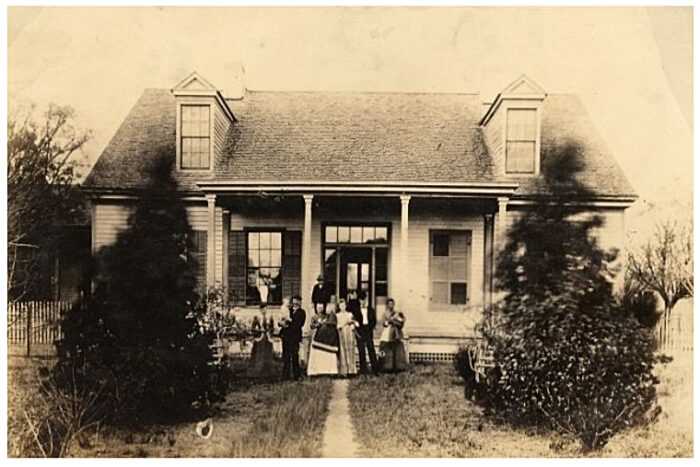
The first house east of the Chavanne building at the big intersection, was that of George Wells, a pioneer lawyer from New York who came to Lake Charles in 1861 at the beginning of the Civil War when the outpost was still called Charleston. When the Champagnes walked past his house almost 50 years later, he’d died 2 years before at age 72, but his (much!) younger widow lived there with their 3 daughters the same age as the older Champagne children until 1911 and could have easily known them in school. The house, however, was demolished in 1912 and replaced by a brick commercial building.
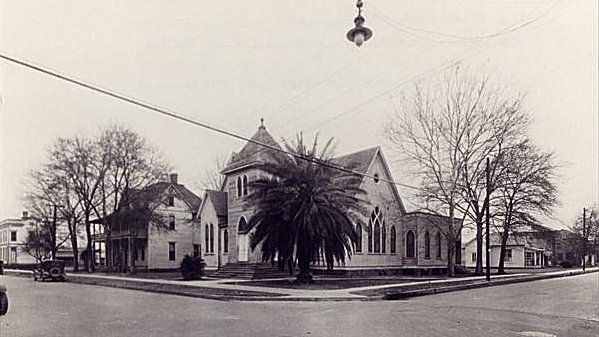
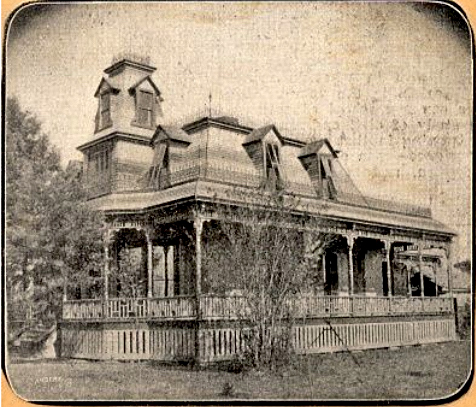

Caption by Maude Reid: “Leopold Kaufman – immigrant from Alsace-Lorrain who became the town’s richest citizen and president of the First National Bank. Mr. Kaufman came to Louisiana from France in 1872, coming to Lake Charles in 1879.”
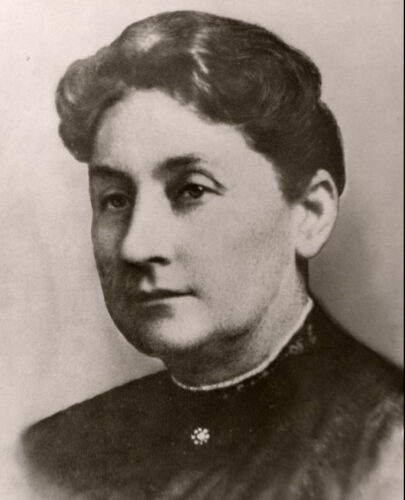
On the next corner was Leopold Kaufman who’d been 29 when he came to Lake Charles, started his first store in a building he rented from Ged Gray (the grandfather of Mathilde, one of Tisoleil’s piano students), and was wealthy enough to build his beautiful Broad St home 10 years later, in 1889. Soon afterwards, he built the first of the four large brick commercial buildings on the corner of Ryan and Broad. In 1907, when the Champagnes took their first family stroll down Broad, he and his wife Pauline were in their 50s , their 2 children grown, no grandchildren yet, and they would live in that house throughout Tisoleil’s 29 years in Lake Charles.

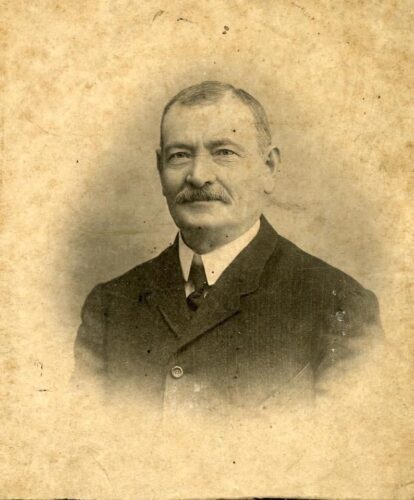

Also from the Alsace region near Germany was Julius Frank, born in 1849, who also came to Louisiana in 1872, and also built a large brick commercial and office building with a large department store on the corner of Ryan and Broad, catercorner from Kaufman. It was immortalized in a photo of Haley’s comet flying overhead. Age 58 when the Champagnes took their first Sunday walk down Broad St, he lived another 22 years, until just a few months before J Euclide’s death in 1929, and like Kaufman, surely cut a familiar figure with the family for 21 years. His 2 youngest boys were Beulah and Carmen’s age.
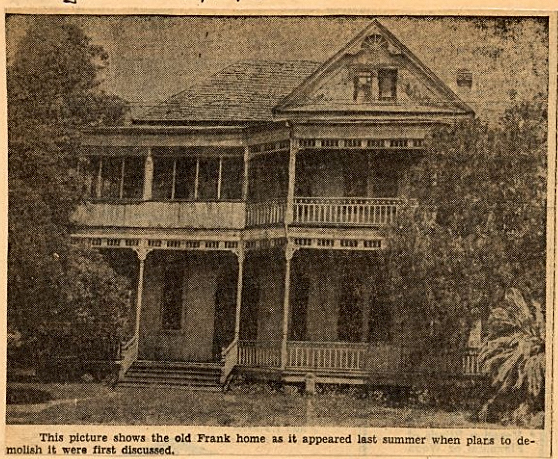
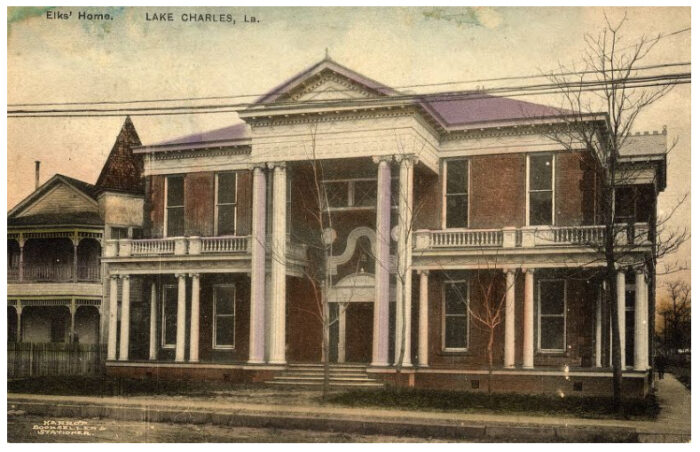

6 – The Watkins bank was built in 1885 by Kansas entrepreneur JB Watkins as the first private bank in Lake Charles, but eventually became the office building for Watkins’ land holding company, which he ran from his home in Kansas. ‘Lake Charles wouldn’t be Lake Charles were it not for him’ is a phrase that could apply to many pioneers in the early years of the settlement, but none more so than Jabez Bunting Watkins, a Kansas investor and promoter. In 1883, his North American Land and Timber Co bought 1½ million acres of land (2343 sq miles) between Lake Charles and Alexandria at prices ranging from 12¢ to $1.25 an acre for the purpose of development as farmland, largely rice, then ran a railroad through it and sold lots at $5 an acre as towns sprouted along the railway. In 1887, he sent out the first mass advertising campaign of its kind, aimed largely at Midwestern farmers, who had experience growing grains. He spent $2000 for penny postcards praising the land and its industrial potential… that’s 200,000 postcards, then sent them all over the Mid-West. He’s the reason rice became a big industry in south Louisiana.
Though Watkins kept offices on the 2nd floor of his bank for when business called him to Louisiana, and didn’t fully sell all his interests in the North American Land and Timber Co. until 1911, he kept his home in Kansas. By the time the Champagnes walked past his bank building, he’d long since returned to Kansas.
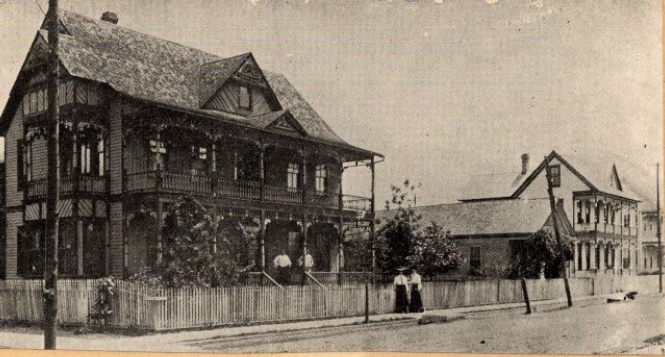
A boarding house when the Champagnes passed by, it remained so until the hurricane of 1918 picked up the entire 2nd floor, with roof, and threw it onto Hodges St.
Don’t believe me?
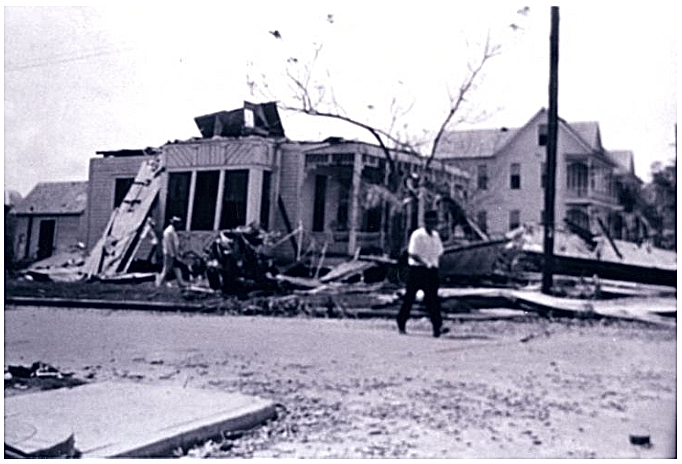
An interesting shot dated Aug. 1910 that shows the Powell boardinghouse, Watkins Bank across from it, and a tiny corner of the Elks Club balcony, is one of several documenting the construction of the lovely Carrara marble post office begun 2 years after the Champagnes arrived. A partner photo taken from another angle a full year earlier shows surprisingly slow progress made during that time, which made me curious. Both photos noted the contractor as a Gude Co. out of Atlanta. Atlanta?… for a magnificent government building of Carrara marble? They’re not gonna go to their favorite architect for such a showpiece public building, the famed Favrot and Livaudais firm out of New Orleans? Actually, they were a little busy, right there in Lake Charles, rebuilding the Courthouse, City Hall, and the Catholic church complex as fast as they could after the fire had destroyed them all in a single day. In fact, I think that fire and those 3 public structures were what started Lake Charles’ relationship with Favrot and Livaudais. The post office, which stayed safe in its old location in the Calcasieu Bank, would have to wait a bit and make do with another designer.
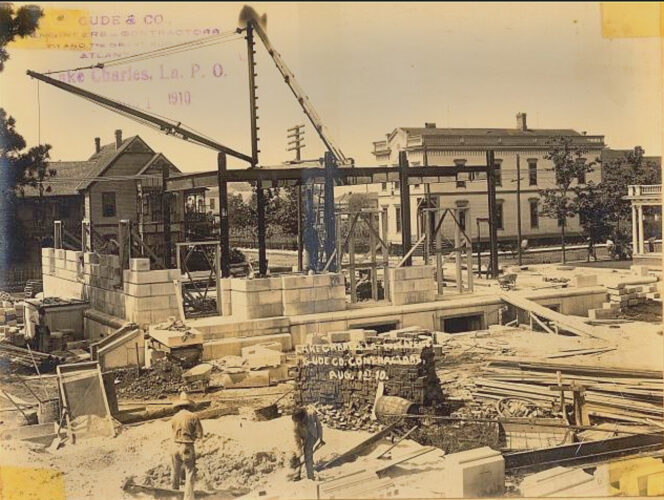
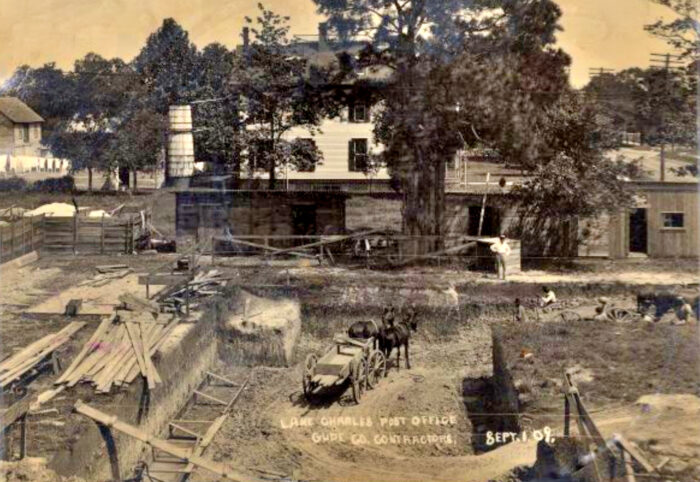
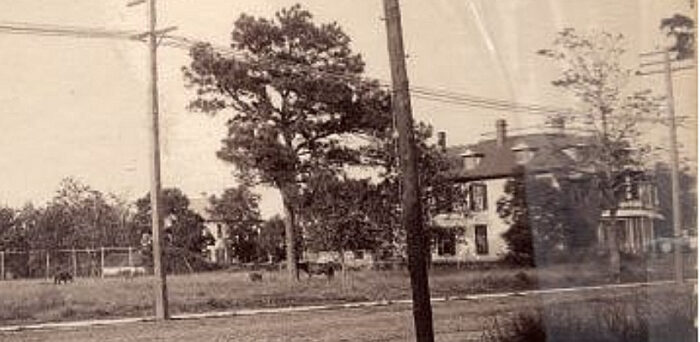
They will not, however, see any sign of the post office. Just an empty field, a lopsided tree, and maybe a few animals, or some children playing.

Dr. Almon Pierce came to Lake Charles from Wisconsin around 1890, possibly in response to JB Watkins’ nation-wide ad campaign promoting the region. He was 48 when the Champagnes passed their lovely home, with 2 daughters, the younger one Lucille being Roosevelt Champagne’s age. So maybe they got to know each other at school. The Pierces lived in that house until Tisoleil graduated from the Conservatory in 1929, when the doctor was 70 and probably no longer working, then suddenly they’re in a tiny house they’ve bought at the south end of town. The market crash must have hit them hard. – McNeese archives
~~~ (*aside*) Chavanne family ~~~

There are so many tidbits of data about the Chavannes in the records that a real portrait of the immigrant experience takes shape. I don’t know if the Champagnes, deeply insulated within the Cajun culture of St Martin Parish, ever had any exposure to an immigrant culture, the struggles, adjustments, the communication barriers, languages from Germany, Denmark, Scandinavia and Russia. And lumber-baron-sized wealth, a culture in its own right, bringing American northern ways from Michigan with it. But the Chavannes represented one of many cultural microcosms of the town the Champagnes had moved to, theirs being eastern Germanic French, from near the German and Swiss borders.
Old Madame Chavanne was a newlywed when she and her young husband left their home in the Jura Mountain region of France near the Swiss border, sailing for America in 1858. She endured late pregnancy and childbirth aboard their ship, and they landed with their 5-week-old daughter Esther in New Orleans, by way of Cuba, in August of that year. [I read somewhere that the shipping line gave ‘its’ baby Esther a lifetime pass to sail anywhere she wanted free, something she never took them up on. I’d like to think this special notice hints that the captain gave her some special care, use of the ship’s doctor, maybe a more comfortable sleeping area.]
They settled west of New Orleans on an alluvial ribbon of fertile land, a twin ribbon split by Bayou Lafourche, that wound through the rich ecosystem that is the Atchafalaya Basin. Did Eugene Joseph Chavanne ever venture into that fascinating swamp out of curiosity, or for occupational purposes, or simply to catch fish for his family’s table? I wonder what he thought of his strange new neighbors eating alligator. Was he there long enough to experience any of the seasonal floods that flowed into the Atchafalaya from the Mississippi River, or the area’s Yellow Fever that Europeans had so little immunity from? Who knows, but he must have decided that living off of the land, be it farming or fishing, was not for him, because 2 years after landing in New Orleans, they went back to the city to catch a ship bound for Orange, Texas. If he thought he’d escaped the Yellow Fever scourge of south Louisiana’s hot mosquito months, he was mistaken, because after their ship had left port, they found that they’d both brought it with them from New Orleans. How Madame Chavanne must have come to hate ships! And knowing that they eventually settled in Lake Charles, we know they didn’t escape floods there either.
We do know that Eugene Joseph proved to be a fine ‘numbers man’ as a merchant, and that his sons would follow suit, first with his stores, and later in real estate sales and insurance. Their time in Texas was brief, as the Civil War saw Eugene J conscripted into the army and assigned to a supply unit just the other side of the Sabine River from Orange, Texas, back in Louisiana, in Niblett’s Bluff where he moved his family and opened a store in 1867. In May of 1875, he relocated for the last time to Lake Charles and opened a general store. I don’t know if his origins in France near the Swiss border helped create a bond between him and the two Germanic Frenchmen from Alsace, Julius Frank and Leopold Kaufman, who owned the NW and SE corners of Ryan and Broad, that led them to recommend buying the NE corner. But in 1879, he did just that, buying a big 200′ lot for $1100 that ran up Ryan St for 2/3 the length of the block. He built a 2-story general store on the corner that housed the family upstairs, then a grocery and bakery with lunch room, all from the local pine. He kept building little 1-story stores, probably for rental. By 1885, there was a saloon and furniture store. By 1889, a hardware store and a drug store had been built. Somewhere in there, he built the family a large home a couple blocks up Broad St. which he didn’t get to enjoy for long. In August of 1890, Eugene Joseph Chavanne died suddenly and unexpectedly from a brief illness. He only got to meet the first 3 of his 28 grandchildren, daughters of his oldest daughter Esther (of trans-Atlantic birth) seen in the 1891 photo above. And he never got to see the fine brick commercial building that his sons replaced his little wooden business complex with, the first of the 3 big brick storefront-and-office complexes that the Champagne women saw on their first shopping foray down Ryan St.
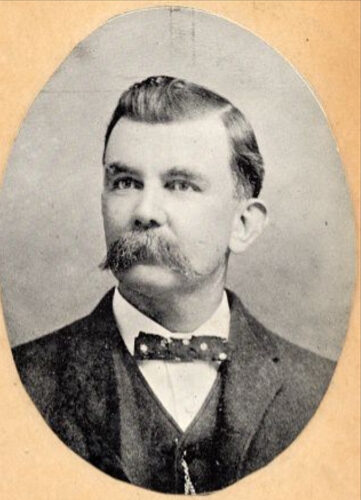
After Eugene died, one of his younger sons Charles went to work at the Southern Pacific freight depot where J Euclide worked when he first arrived, though he’d left to join the family real estate agency by that time. His oldest son Francis, who’d taken over the bakery in the family cluster of little wooden stores on Ryan near Broad, earned this comment from Miss Maude. “Mr. Chavanne, who has lived in Lake Charles since 1875, was one of the town’s early bakers. I recall with delight his delicious currant buns – I’ve never eaten any as good since then. When he delivered bread to my mother in the afternoon, it was a great treat if the delivery included currant buns. Later, at the turn of the century, he became a real estate man and was quite successful.”
The Widow Chavanne finished raising their children, the last leaving home to get married in 1904, and lived in the Broad St home for many more years, enjoying the fruits of the family businesses in the fine brick Chavanne building Eugene’s sons replaced his wooden storefronts with. Let’s hope she was not the kind of mother who looked forward to having some peace and solitude in her own home when her kids were grown and gone, because by the time her youngest was gone, her older ones had already presented her with 18 grandchildren. Worse and more of it [just kidding], only a few years later, the first of her grandchildren to get married, Estelle Jonté, would move in with her and bring her shiny new husband with her. It was the first of what would be a series of newlywed Chavanne grandchildren and their spouses who would briefly move into the Broad St home as a jumping-off point to finding their own place.
~~~
When the Champagnes walked past the Chavanne house in 1907, old Madame Chavanne, now 71 and widowed for 17 years, had 23 grandchildren most of whom were likely there at their grandmère’s for Sunday dinner after church, the same Catholic Mass the Champagnes had just come from. If they weren’t inside sitting down to dinner, they’d have been scattered around the front and back yards, their parents rocking the afternoon away out on the front porch. Eighteen of the Chavanne grandchildren were within the same age range as the Champagne kids, so they could well have noticed each other with particular interest. If the French Chavannes sent their younger children to Catholic school, rather than the public school, would they have had the chance to get to know the Champagne kids? Maybe not, but there was only one high school, and the older kids would’ve been all together, likely taking the same streetcar that ran in that direction. Seeing the Champagne family walking down Broad, looking around like tourists, what did the Chavanne children see? Did the newcomers seem different? From somewhere else? Of a lower socio-economic strata? The Champagnes would have dressed in their Sunday-go-to-meetin’ best, but I’ll bet the clothes of a rural sugar cane farming family, even their Sunday best, were not as new, not as fashionable, and not as well made. What did the Champagnes see when they looked back at all the people, old and young, in and around the Chavanne home? Thanks to a Chavanne family portrait taken around the summer of 1908, we have a pretty good idea what the Chavannes and their happy chaos, complete with dog and pony, would have looked like to the Champagnes. I think it was taken at Clarice Chavanne Pavia’s house ‘in the country’, a few blocks south past Pithon Bayou, possibly celebrating the marriage of her niece Estelle Jonté, the first of the Chavanne grandchildren to get married.
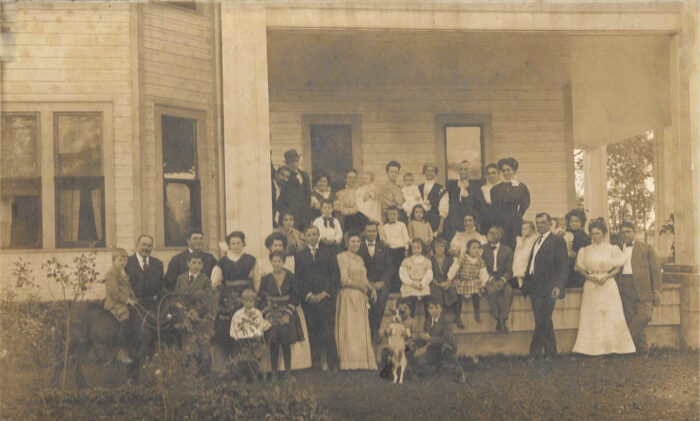
Estelle’s husband, Isaac Murrey, was a professional photographer whose photos from Tisoleil’s years in Lake Charles appear in my posts thanks to the McNeese archives and Maude Reid, including my favorite of the brave men on the roof of the old Knapp drug store building fighting the fire with a hose strung across the street from the Majestic Hotel. The Murreys would eventually buy a house the Champagnes might have seen on their first day’s carriage ride from the train depot, the house that Tisoleil’s cousin Quinta Babin would live in for a while. It later attained a bit of local folklore fame for being haunted by the victim of a murder supposedly buried under the living room floor. A square cut in the floor boards between the livingroom and dining room, traditionally where the grate for the floor furnace was cut, was instead used as supporting evidence of that.🤣 The Chavanne house enjoyed a happier fate, representing the fast-disappearing tradition of being a 3-generation home much like my Tisoleil’s beloved home was for me. When the Widow Chavanne’s oldest daughter Esther (of celebrated trans-Atlantic birth) was widowed following her husband’s death in a freak streetcar accident, she moved in with her mother permanently and continued the tradition for the rest of her 84 years. In 1960, Esther’s daughter Eugenie was still in the house, renting to lodgers.
~~~~~~~~~~~~~~~
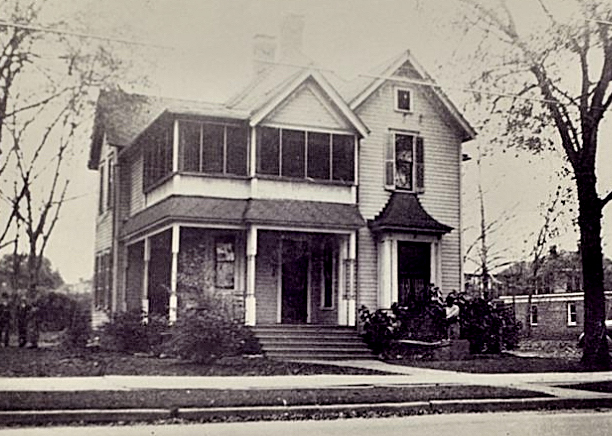
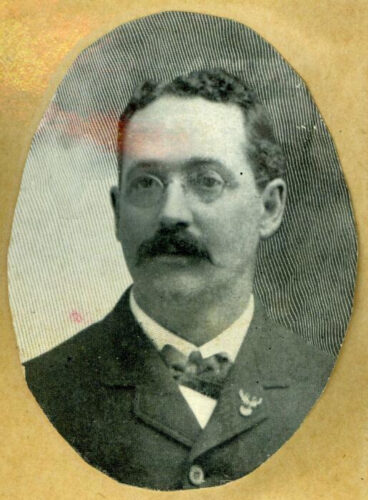
North was a ‘Michigan Man’, brought to Louisiana as a banker at First National Bank by its directors who were high-powered lumber magnates out of Michigan, Robert Nason and William E Ramsay. North’s two children were Carmen and Presley’s age. Perhaps they met in high school.
Nason and Ramsey came to Lake Charles from Michigan in the 1880s after the northern forests were depleted, bought land at rock bottom prices intended by the government to help the former slave population establish homes of their own after the Civil War. They opened the Bradley-Ramsay lumber mill on 2 sites, the old Goos mill and W. L. Hutchins’ oldmMount Hope mill. They built magnificent homes on Broad St., eventually bringing their families with them but never cutting ties with Michigan as their home base. Bradley-Ramsey became the largest employer in Lake Charles which, with today’s hindsight, could arguably have had as detrimental an effect on Louisiana as beneficial. Back then, though, running out of forest was inconceivable, and reforestation wasn’t a twinkle in anyone’s eye yet. The main ‘twinkle’ in Louisiana’s ‘eye’ after being financially ruined by the Civil War was its desperation for an infusion of cash, industry and entrepreneurship from out-of-state investors. Men like J.B. Watkins fit the bill, actively promoting real estate development, agricultural business, and infrastructure that left Louisiana much better than he’d found it. Nason and Ramsey, not so much.
The out-of-state lumber industry was a rapacious business that travelled around the country turning millions of acres of ancient forests into barren stump-scapes, sending profits back to the company’s home state, in Bradley-Ramsay’s case, Michigan. They patronized Lake Charles businesses as little as possible, instead building company towns with company-owned stores, investing nothing in Louisiana businesses that would only compete with their own. When the forest ran out after one or two decades, they abandoned the community for the next location, taking the community’s jobs and means of support with them. “Cut out and get out” was their way, having provided nothing in return for the forests it stripped bare except the wages paid to do the stripping. Many of the company towns rotted so thoroughly into the ground that no sign of them remains.
When Bradley-Ramsay ‘got out’ after 20 years, selling to a Kansas firm in 1906, the chief executives did leave their magnificent showcase homes behind, up and down Broad St, which the Champagnes saw the following year. Its executives, now elderly and retiring back home to Michigan or sunny California, sold their homes to the local mill owners and businessmen, wealthy grandchildren of the founding pioneers. They gave these homes a 2nd life, but also a new interconnectedness since the new families, whose kids ran in and out of each other’s homes, were in-laws in one way or another. In 1907, the Champagnes were looking at a neighborhood that had completely changed hands the year before.
~~~ Ramsey-Miller house and the Miller/Lock story ~~~
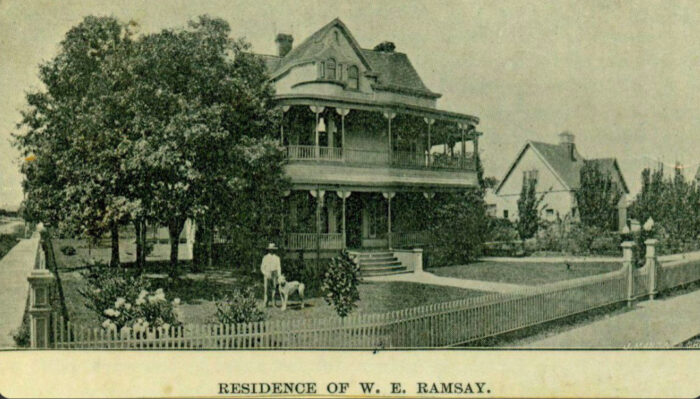
Across the street from Newton North’s house was the home of William Ramsay, chief executive of the Bradley-Ramsay lumber mill.
One of Bradley-Ramsay’s major contracts was with the government, making railroad ties and ship decking for the navy and merchant marine. I’m sure Roosevelt (Tisoleil’s older brother), a merchant mariner all his life, never knew that the decks of the ships he sailed to all corners of the globe in were built of yellow Calcasieu long-leaf pine from back home.
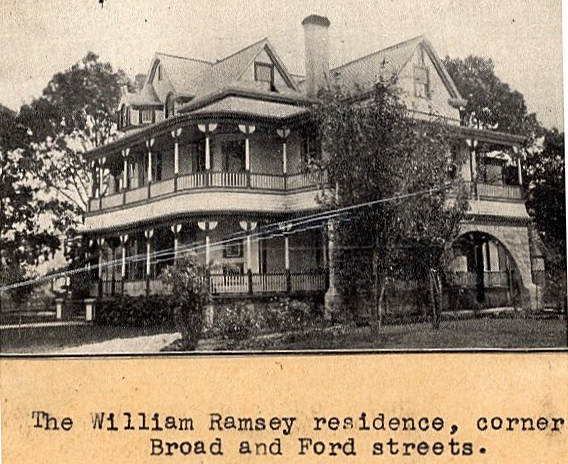
The Champagnes would probably not have ever known old W E Ramsay or his family unless they saw him and his furniture moving out of the house, bound for the sunny climes of Los Angeles. (And he went in style; he sold his stock in the company and made $2,500,000. I don’t know if those were 1906 dollars or modern dollars, but still…)
If the Ramsays had already left, the Champagnes may have seen the family of Mathilde Miller, a wealthy widow of 54, settling in with her teenage sons Albert,18, Edgar 15, and Ernest 14. Kid brothers of 3 married sisters and adored uncles to their 6 kids, every one of ’em girls, they were probably used to the testosterone level of the house getting a good run for its money.
Carmen would get to know Edgar in a few years being bank tellers together at the Calcasieu National Bank.
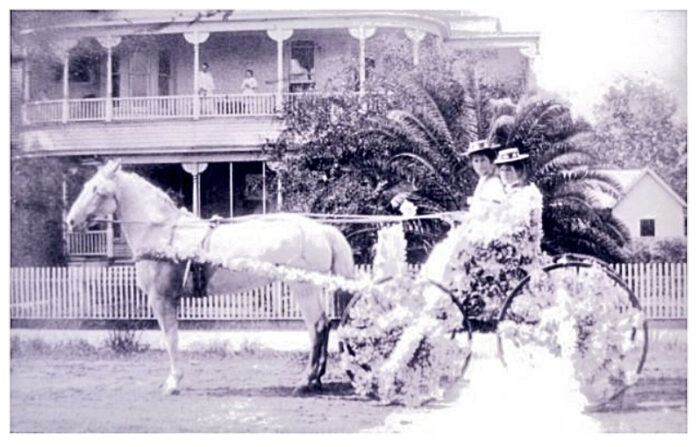
Mathilda, originally from Denmark’s Foehr Islands in the North Sea, came to Lake Charles in 1872 when she was 19 and married a Swedish immigrant who worked his way from being a laborer to a wealthy mill owner in Westlake, opposite the lake from Lake Charles. When he was 54, in Texas visiting a health resort, he was killed in the deadly Galveston Hurricane of 1900. Soon after, his junior partners Rudolph Krause and William Managhan stepped up to take over the company. Small world. Tisoleil grew up next door to the Krauses, and their youngest, Karl, was one of her best friends. And Managan’s oldest son W H, Jr, who was 12 when the Champagnes arrived, would grow up to marry a well-educated pianist from Missouri and bring her home. Mrs. Managan took special interest in Tisoleil’s piano studies. and was instrumental in finding funds toward a scholarship for her to go to the Conservatory of Music in New Orleans.
Anyway, the Widow Miller bought the house from Ramsey and moved from Westlake into town with her 3 teenage sons. Some time later, she remodeled the building in much the same manner that Mrs Julie Muller of Muller’s dept. store remodeled Maude Reid’s childhood home at 511 Hodges (see previous post), replacing the delicate Eastlake balconies with massive Lake Charles-styled box columns, which is how the house appears today.
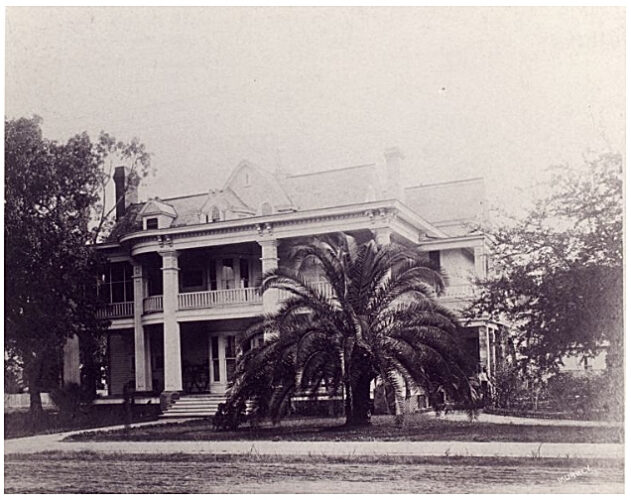
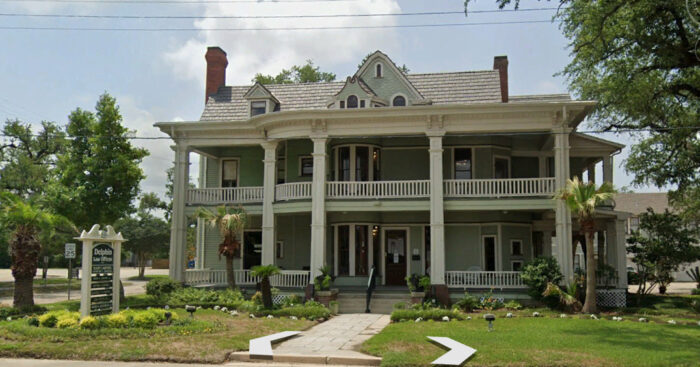

At first, I didn’t give much thought to the absence of Mathilda’s eldest girl Mamie from this informal family shot, or Mamie’s youngest daughter Selma, when the older two, Irma and Elaine, are present. But now I think there’s a sad reason for that, which may in turn have had some influence on Mathilda’s decision to buy a bigger house. Granted, that’s when Ramsay chose to sell his house. But the 1910 census shows that Mathilda had taken in the older 2 of Mamie’s 3 girls (15 & 13), and the youngest one (11) had gone to live with her other set of grandparents a block away, her father’s parents, Capt. George and Ellen Goos Lock.
The girls were separated?
I couldn’t find either parent in the 1910 census, but Mamie’s death certificate and subsequent succession had a lot of information in them. Mamie Miller Lock died in July of 1914 in Moody’s Sanatarium in San Antonio of ‘nervous prostration’, with contributing factors (longer term) also listed as nervous prostration. She was divorced and had been living there for 4 years, since 1910, but her succession states that as far back as 1902, when the girls were only 3, 5, & 7, Fred G Lock had asked to be appointed curator to his wife Mamie by virtue of a judgment of interdiction, meaning Mamie was no longer able to manage her affairs or her family’s. She was 29 and Fred 30, and this must have made for a great deal of pain in their marriage. The last I could find of Mamie alive was in a family portrait, around 1906, on the front lawn of her in-laws down the block, the Locks, where her youngest would later live. Could Mathilda Miller have seen the divorce coming and wanted a bigger house in case her daughter and granddaughters moved back in with her?
Wherever the girls’ father was for the 1910 census, December of 1913 found him at the far west end of Canada, in Vancouver, getting remarried. He returned to Lake Charles and built his young new wife a fine home a block further down Broad from the homes of his brother and his parents. Irma, the oldest, had gone to live with her father and new wife by 1915, but that may have been because Mathilda had already planned to sell her house and buy a 1-story place across the street between George Lock Jr and Sr that was coming up for sale. By 1917 though, Mathilda Miller now in her new place across the street, Irma, now 22, had left to join Selma, 18, at Capt George and Ellen Lock’s home. I think the informal family shot at Mathilda’s home was taken near the time Mamie was institutionalized in Texas, while Irma and Elaine were living there, looking much as they did when the Champagnes walked by a couple years earlier. I also think it’s possible that their father’s remarriage could have been the tipping point for Mamie, because 7 months later she was dead at 41.
~~~
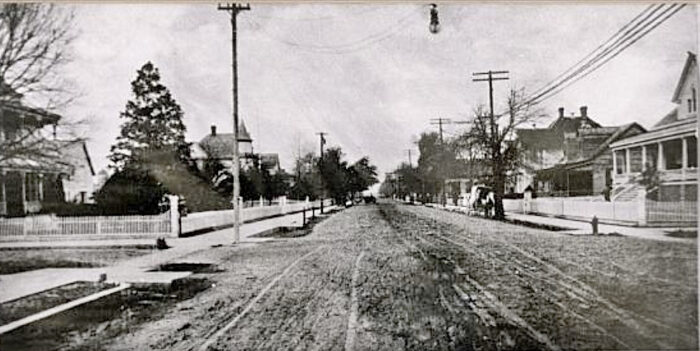
Back to the Champagnes on their first Sunday walk after church. (Please!) If they’d gotten to the corner and turned around to take one last look at the Ramsay-Miller house, the block would’ve looked like the following shot, taken 2 years before.
Caption by Maude Reid, with edits. “The William Ramsay home on the left, bought by Mathilda Miller around 1907, and beyond that, the turreted home of dentist Dr. Anderson. Across the street – the cottage with the dormer windows – is the old Lem Dees home and beyond that is the home of the Michigan banker Newton North. The house at the extreme right, across from the Ramsay home, belonged to Leon Viterbo, a rice industry executive from Istanbul, Turkey.” (close quotes, sorta, with apologies to Miss Maude for a few corrections)

Continuing on across Ford St, they’d have passed the little wooden Presbyterian church on their right. And just for the sake of completeness, I should include the home of N. D. Pope, which was 2 doors back from the church, on Ford.
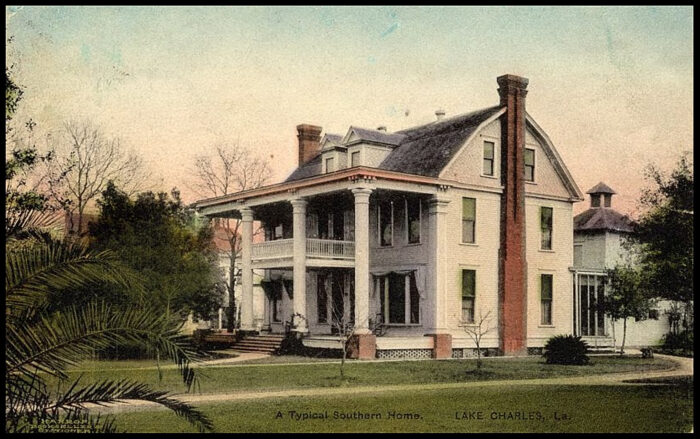
Pope was the only one of Bradley-Ramsay’s Michigan executives who didn’t build his home right on Broad St. Pope was also the only one to stay in Lake Charles past the 1906 sale of the Bradley-Ramsay company, perhaps because he had branched out as president of Hodge Fence Co. Or maybe it was because his only child died in Lake Charles in 1900 when she was 18, after being sick for several weeks, and they could not bare to leave her. Eventually, though, leave her they did, in 1924, moving to Oregon… when he would’ve been in his 80s?! Why would anybody that age choose to make an exhausting move across the country?
Rounding out the 4th of 4 homes that made the intersection of Broad and Ford a Bradley-Ramsay residential enclave is the home of Robert H. Nason, the first of the Michigan men to come check out Louisiana, forming a lumber company in 1881 that he soon merged into Bradley-Ramsay. He built his fine home in 1887 and split his time between his home in Michigan with his family in the summers, and his house at 705 Broad St in Lake Charles over winter.

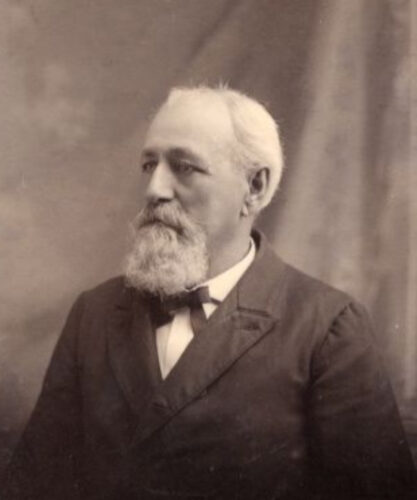
Caption by Maude Reid: “R.H. Nason who came to Lake Charles in the early 80’s from Michigan. Built several fine homes and then returned to Michigan. Bought the entire square bounded by Hodges, Mill, Moss and Division and contributed his name to a rambling boarding house on the square – ‘Nason Villa.'”
He bought that block from Dr Abram Moss who’d built a large Queen Anne house in the center with a 3-story tower topped by a mansard roof. You saw it in J Euclide’s first walk to the S-P freight depot. Though the block became known as Nason Villa, Nason never lived there. And though the boarding house became known as Hayes House, Moss had lost his first wife, maiden name Hayes, and remarried by the time he moved to Lake Charles and built the house. Its origins aside, its back door was directly facing the Moss St home my Tisoleil would grow up in. By the time she was there, her best friend Bernard Levy’s house had been built across the street, directly in the line of sight to the Hayes boarding house, but she’d have seen it from everywhere else but her front door, though she’d have see its turret above the Levy’s roof from there, too.

Back to his Broad St house, though. Nason, who turned 70 in 1901, may have retired, rejoined his family in Michigan, and sold his home in Lake Charles before the dissolution of the mill. It may have been the family of F. E. Newcombe, an Englishman and lumber exporter with 3 boys around Tisoleil’s age, in the house when the Champagnes took their Sunday stroll down Broad. But they only stayed a couple years, so it may have been the next owner in the house, Arthur Wachsen, at which point the home found itself in the hands of a Lake Charles pioneer family.
Mathilda Miller had married her two older daughters to grandsons of the Capt. Daniel Goos, a Lake Charles pioneer and founding father, but more importantly, a fellow Foehr Island countryman. Mamie married Ellen Goos Lock’s son Fred in 1893 and Hilma married Rosalie Goos Wachsen’s son Arthur in 1900. Like Fred’s father, Capt. George Lock, who’d been brought into the lumber shipping business by Capt. Goos, Wachsen’s father had been a Prussian ship captain for Capt. Goos based out of the Galveston side of the Goos business before he married Goos’ daughter Rosalie. Their son Arthur owned a dry goods store around Capt. George Lock’s lumber mill west of Lake Charles, Lock not only being his father’s brother-in-law by marriage to Goss daughters, but his son Fred being Wachsen’s brother-in-law by way of their marriage to the Miller girls. Confused?!
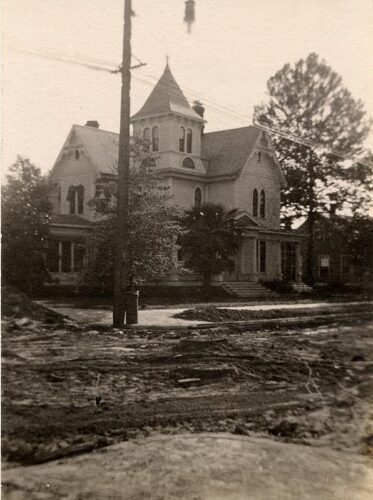
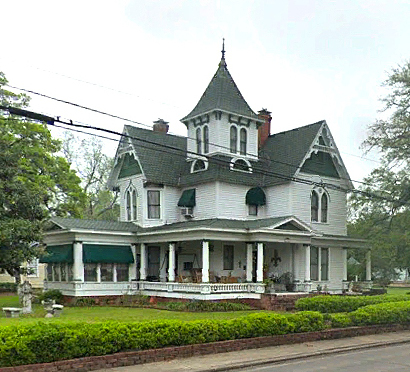
Anyway, Wachsen bought the Nason home right around the same time as his mother-in-law Mathilda Miller bought the Ramsey home catercorner from it, both taking advantage of the sudden appearance of showpiece homes on the market following the dissolution of the Bradley-Ramsay mill. He kept his Westlake store but branched out as president of a small lumber mill. When movies became a new source of entertainment, he branched out further still into the Nickelodeon movie house business. The Wachsens lived in the home until mother-in-law Mathilda Miller’s death in 1923, when they inherited her home, which was no longer the big Ramsey place. Around 1916, the widow Mathilda Miller, now 63 with all but one of her children grown and gone, had sold the cavernous Ramsey mansion and bought a smaller home 3 doors past the Wachsens, a lovely 1-story raised villa a few doors past her daughter in the old Nason home.

It had been built around 1905 by William A Guillemet, a New Orleans banker, who, 10 years later, had had to move his 4 young children and his wife Pearl, aged 41 and gravely ill, back to New Orleans so she could die at home.
The year 1918 was a fateful year for the Millers and Lake Charles. Before buying the Guillemet house, the wealthy Widow Miller had built a home for her newly-married son Edgar, possibly as a wedding present, that was a showcase Craftsman ‘airplane’ bungalow a few blocks away.
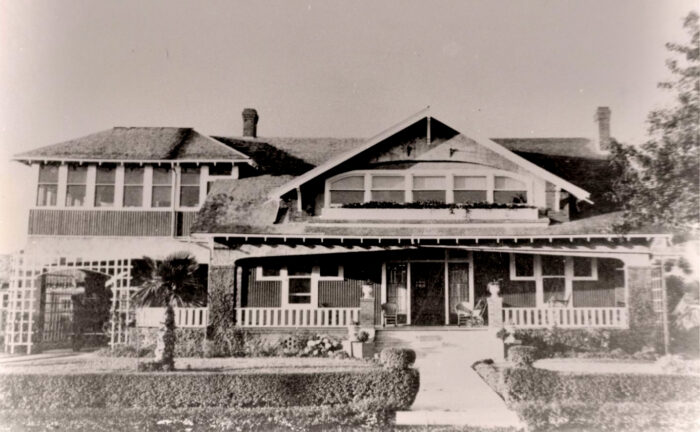
Soon after they settled in, Edgar left the bank where he’d worked with Carmen and joined his brother Albert’s car business. Albert, whose first job had been as a machinist with the MoPac railroad, must have loved machines, because by 1913, he opened one of the town’s first automobile dealerships. But 1918 saw metal and rubber going toward the war effort, and car manufacturing shift its focus from personal vehicles to military use. And then the hurricane of 1918 hit Lake Charles broadside. Mathilda’s succession from 1923 tells the tale.
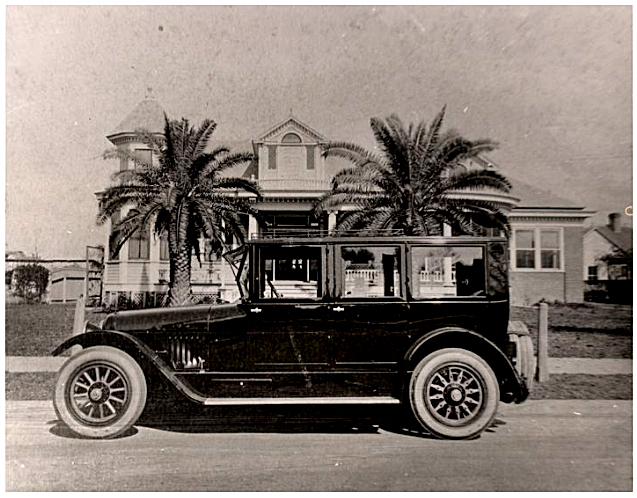
Her succession, as well as a photo, refers to her having a 2nd hand Mercer, bought around 1919. Did she buy it from her son’s business? To me, the real question is why a woman of her wealth would buy a second-hand car. I’ll bet the devastating 1918 hurricane which destroyed homes and businesses all over town caused a lot of automobiles, which were still considered luxuries rather than necessities in life, to be returned by or repossessed from people who’d been ruined. Maybe she bought it from her sons to help their suffering business, one of whom had just left a good job to join his brother’s dealership. But maybe it was a second-hand car that she bought because not enough news ones were going to the civilian market. And the start of WWI earlier that year, diverting metal, rubber and able-bodied men away from pleasure driving, couldn’t have helped the Miller boys’ struggling business either. Mathilda’s succession states that by 1923, though he’s listed as part of Miller Brothers auto sales company, Edgar was backrupt, having taken out many loans from his mother.
Mathilda breathed her last in 1923, leaving her house to the Wachsens who, with their only child grown and soon to marry, decided to downsize as Mathilda had, moving into the more manageable 1-story house and renting out the big Nason place. It was during the Wachsen’s time in the house that a further remodeling extended the upper and lower bannisters around Mathilda’s side wing and extended its roof further out to cover a porte-cochere, driveway and side entrance.
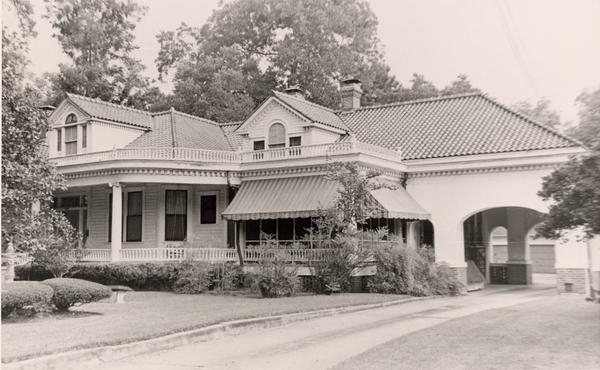
The Wachsens’ daughter Lorraine and husband Clyde Williams took over the house after her mother Hilma died in ’49. She died in 1984, and as she had no children, a large rear wing that exists today was likely added after her time, possibly when the house became a business.

But . . . when the Champagnes strolled along the 700 block on their first Sunday, back in 1907, the Widow Mathilde was just settling into the old Ramsey house with her 14-, 17-, & 19-yr-old boys, all within flirting age of Beulah and Carmen. She may have had her Lock granddaughters, 6, 8, & 10, over for Sunday dinner, if not yet living with her, the two older girls being Presley and Roosevelt’s age. Across the street in the old Nason home, the Wachsens and their daughter Lorraine, 6, may have also been just settling into the Nason home but it’s possible the Newcombes and their 3 small boys all close to Tisoleil’s age may not have quite left yet. And down the block, the Guillemets would be in their lovely new raised villa with their 2 girls, 8 & 4, and 2 boys, 2 & 6mos., and Pearl still had 8 more years of her short life with her young family there. These families, all new to the neighborhood, in their new homes, would not have known that the Champagnes were themselves newcomers. If any of them had been out front with the children, or rocking on the front porch, perhaps with extended family waiting for a big Sunday dinner to be ready, they would likely have inclined their heads in greeting to the Champagnes, and J Euclide and Tiwazzo would certainly have done the same.
Mathilda’s succession stated that her 2nd hand Mercer was worth $1000. Mercers were considered very expensive luxury cars, costing about $2500-$3000 new in 1919 dollars, about 45k-55k in 2025 (x 18.25). She’d fall over if she saw today’s 500k Mercedes cars. Which got me wondering what it meant to be rich back then? Her succession inventory looked like this –
- Her home . . . . . . . . . . . = $7500. (x 18.25= $136,875. in 2025 dollars)
- Real estate investments = $135,125. – ($2,466,031.)
- Promissory notes . . . . . = $220,000 !! – ($4,015,000.) By 47 people!! Was she making loans as a regular business? Many were after the hurricane.
- Stocks . . . . . . . . . . . . . . = $68,100. —– ($1,242,825.)
- Household contents . . = $1879. ——- ($34,291.)
- Bank accounts (cash $74,834., Personal $383,143., Rental income $28,253., tutrix acct $607. (for Mamie’s kids?)
- . . . . . . . . . . total = $486,837. — ($8,874,303.)
- Total = . . . . . . . . . . . . . = $918,834. — ($16,768,720.)
- ———————– Comparison ———————————————–
- William Ramsay’s 1909 estate ………………………………………….. $1,088,208. ($19,859,796.)
- Capt George Lock, 1917 …………………………………………………. $1,108,602. ($20,231.986.)
- J A Bel’s 1918 estate, heavy on stocks and bonds ……………….. $2,094,985. ($38,233,472.)
- Mathilda Miller, 1923, heavy on promissory notes and cash, …. $918,834. ($16,768,720.)
—- ⚜︎ ⚜︎ ⚜︎ —-
But I digress. Another family linked by intermarriage to others along Broad St were the Mosses. C D Moss was the 2nd son of Dr. Abram Moss, who was an early pioneer teacher, real estate investor, and ‘self-taught’ doctor (of questionable training, suggests Miss Maude) from St Landry Parish. He lent his name to the street where my Tisoleil grew up. ‘Dr.’ Moss raised a large family, including his son Clement, in a house on Broad possibly on the original grant of Judge David John Reid (of hot-tempered infamy) near where the Reid family cemetery had once been, back when the town was a remote outpost not yet named.
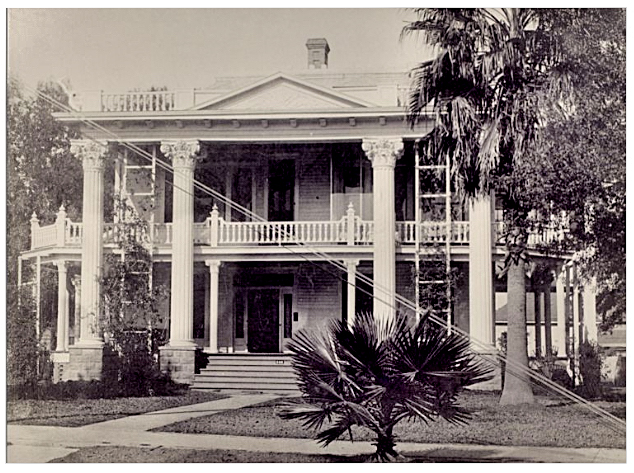
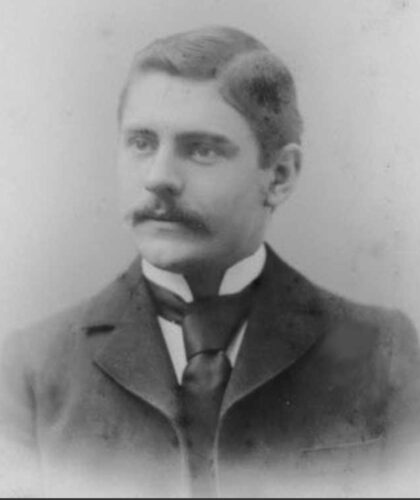
Clement, four years after graduating from law school, would build a fine home for his young bride on the corner of Kirkman St across from Mathilda Miller’s raised villa. A respected attorney, he was also president of the Chamber of Commerce. And by the time the Champagnes walked past in 1907, they had 2 young sons, 5 & 1.
Across the street from the Moss home, at 804… Who knows if the Champagnes saw anyone in that house. Dr Stephen Carter was listed at the house for a few years, but the censuses showed that he never left his home in Cameron, down on the Gulf Coast. Maybe it served as his office in the city during the week, but big enough for the whole family if they wanted to come.

Much like the Bradley-Ramsay execs who went north during the hot summer months, hence were never found in the Lake Charles censuses, which were taken in the summer, maybe the Carters returned to their seashore home for the summer when the census caught them. And since the Carters had 2 girls and 3 boys roughly the same age as the Champagne kids in 1907, and would have 2 more by the 1910 census, who wouldn’t prefer to spend their weekends at the seashore.
~~~
The next house they passed returned them to the Moss clan.
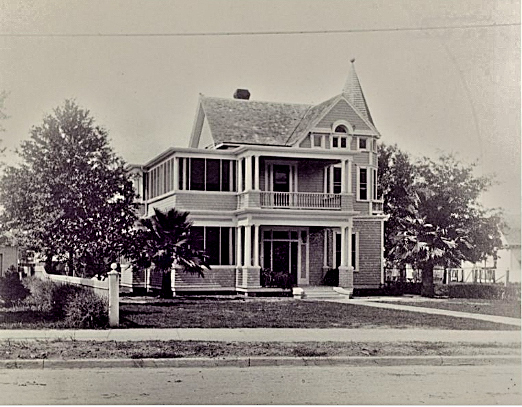
Like CD Moss, several of his younger sisters stayed in the neighborhood after marriage. Emma got married the year after Clement to J Alton Foster, a local executive with a rice mill. And Foster built the house the year after Clement built his. Years later, Alton Foster’s path would cross with Tisoleil’s when she was a newly-graduated piano teacher and his youngest daughter Blair took lessons with her.
Actually, another of Clement’s sisters, Floy Moss, had crossed paths with Tisoleil already. Floy married Ernest Bel, and their wedding present from Ernest’s father JA Bel was a lovely home behind the grand Bel mansion, making them across-the-street neighbors to the newly-arrived Champagne family from the Bayou Teche sugar cane fields. Floy was the mother of Della Bel, whose 8th birthday party photo from 1913, taken in the Bel mansion’s front yard, had Tisoleil in, little Stella as an 8-yr-old, way at the beginning of my Lake Charles research.
A third sister, Delia, married George Lock Jr (brother-in-law to poor Mamie Miller in the Texas sanitarium) who lived on the west side of the lake around Lockport would later build a grand home in the next block. George Jr.’s parents, though, Capt. George and Elmina Goos Lock (co-grandparents with Mathilda Miller to Mamie’s 3 girls) lived in the next house the Champagnes walked past after Alton and Emma Foster’s house. It didn’t look like it had when it was first built, though.
~~~ Lock-Foster house ~~~
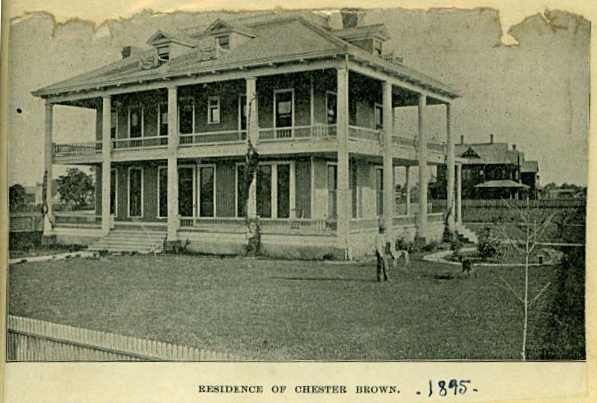
Built in 1895, several years after most of Bradley-Ramsay’s executives had settled into town, Chester Brown, a New York-to-Quebec-to-Michigan man, served the company as civil engineer and treasurer for only 5 years before an untimely death at 42. His widow returned to Michigan with their daughter shortly afterwards and the family left very little footprint on Lake Charles, except a lovely home. By the time the Champagnes walked past this house, perhaps getting ready to turn the corner to head for home, the house had been bought by Captain George and Elmina (Ellen) Lock. They would become the hub around which the network of Miller-Wachsen-Moss-Foster in-laws along that 3-block stretch of Broad St. would revolve. They would also become a haven for widowed elders and orphaned nieces in the family, which is probably what prompted them to build a substantial west wing onto the house.

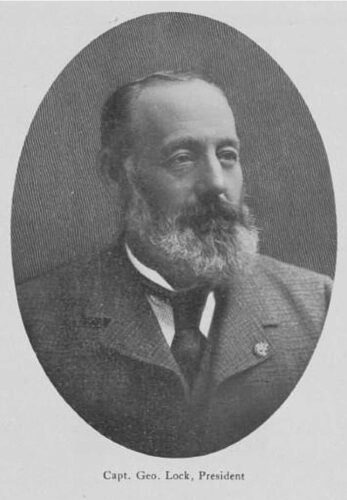
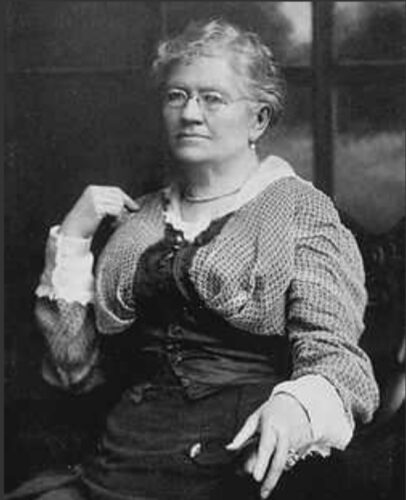
Capt George Locke, a wealthy lumber mill owner in Lockport, west of the lake, bought the house around 1905, perhaps with retirement in mine. He was 67, his wife Elmina Goos was 58, and their son, 25 and not yet married, had recently moved in when the Champagnes walked by. But there may have been many people over for Sunday dinner.
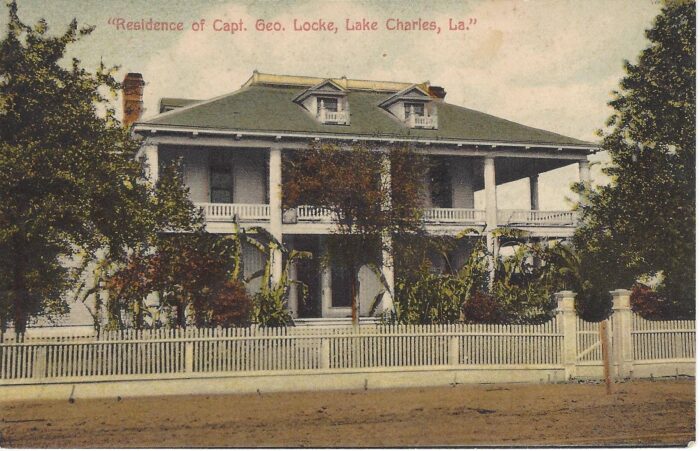
The house during the Locks’ tenure, especially under Miss Ellen’s well-known generosity, became as known for being warm and welcoming to extended family in need as the house under Chester Brown’s ownership seemed distant and uninvolved. The 1900 and 1910 censuses tell the tale, first at their Lockport home and then in Lake Charles. Among those living with the Locks at one point or another were the Captain’s elderly widowed sister, Miss Ellen’s elderly widowed aunt, Miss Ellen’s nieces Maggie, 11, and Rosalie, 6, by her deceased sister Medora, her granddaughters Selma, 8, and later, Inez, by her son Fred, and their married daughter Letitia. Though Letitia’s listed in Kansas City, Missouri with her new husband, a chief engineer for the railroad, she is mistakenly listed twice as also being back home with her parents with their 1 year old and 4 month old. A little help down south from mom and the aunts, maybe?
There is a family portrait from around 1905, taken in the front yard, where they look much as they would’ve in 1907 when the Champagnes first walked by their house.
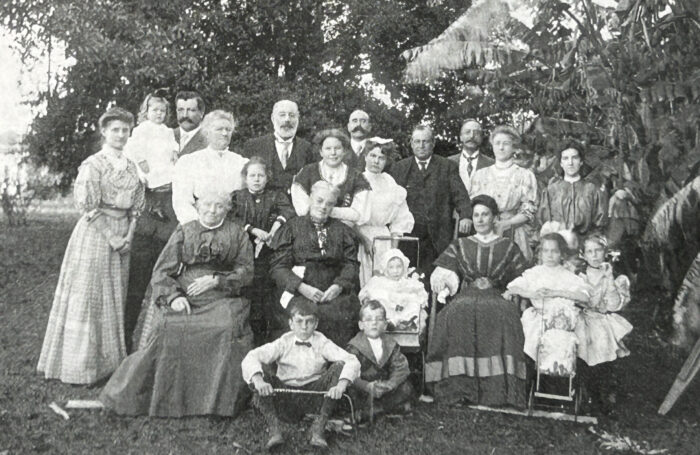
Capt and Ellen Lock are the white-haired couple standing left of center. Oldest son Fred is standing right of center in dark suit and vest, his hand on his wife Mamie Miller’s chair. Younger son George Jr, standing at left holding his baby daughter Delia is with wife Delia Moss(Deetsie). The woman standing at far right may be the Locks’ daughter Letitia whose husband is standing 2 to the left. Their 4 children’s ages span those of Presley, Roosevelt and little Stella Champagne, but they lived in Kansas and were only visiting. George Jr, Deetsie, and daughter Delia, who were still in Lockport west of the lake, may have been over more often, and after 1910, they too moved to town, building a house right on the opposite corner from the elder Locks. By the time the girls started school, they’d be in the same class. If the children were outside on the lawn when the Champagnes walked by, perhaps the little 2-yr-olds’ eyes met.
When the Captain died 10 years later, in 1917, and the much-beloved Miss Ellen 4 years later, the house was sold to the Locks’ neighbor to the west, J Alton Foster, who was Delia Moss Lock’s brother-in-law through her sister, his recently-deceased wife Emma Moss Foster. Alton remarried at age 47, a year before his daughter Mary Belle married, and both father and daughter had a child within the same year. Alton’s child, Blair, who was 26 years younger than his first child, one of Tisolay’s students, was one of two flowergirls at Ti and Granddaddy’s wedding.

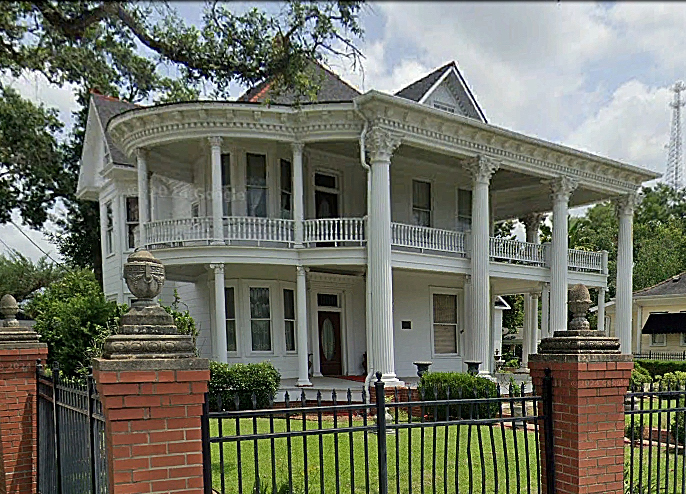
This house is a mystery to me. I know that Dr. Charles W Loomis, an eye, ear, nose & throat specialist, was born in Ohio but grew up in Kansas. He came to Lake Charles and was settled into his practice by the time he was 28, in 1895. Eight years later, on the day before Christmas, he married a Lake Charles girl whose parents were from his home town but left when she was 2. When he was 39, they had their only child, Dorothy, who was a year younger than Tisolay. It was around that time that Loomis built their fine home in the 900 block, the only house on an otherwise empty field.
What I don’t know is why there’s no picture of it in the archives, no stories about Loomis, nothing from Maude Reid, and only bare bones mention of it in the architectural preservation records. There was mention of there being a commercial add-on that obscured the front for 60 years, but that it had recently been removed. We’re not even sure it had been built yet when the Champagnes walked by, 1904-1909 is the window. It, and they, were there when the two little girls started school, though, and they were there until Tisolay was married and gone. Did little Stella know Dorothy Loomis from school?… 12 years, just a grade apart?
In any case, they’d have likely turned up Reid to head home, their heads swimming with wonder about what the insides of those homes they’d just seen were like, and the lifestyles of such wealthy people. And they’d have likely returned home pooped from such an intense day, seeing so much, and lain down for a nap, all except Tiwazzo, and maybe Beulah, who had to get their own Sunday meal.
And life remained relatively like what I’ve imagined in these 3 hypothetical walks I just took with my grandmother’s family for about 2 ½ years, until April 23 of 1910, when the great fire changed life as Lake Charles knew it.
~~~~~~~ cont’d on next post ~~~~~~~
================================================================================
[for my own organization: 31 screen pgs, 53 shots]